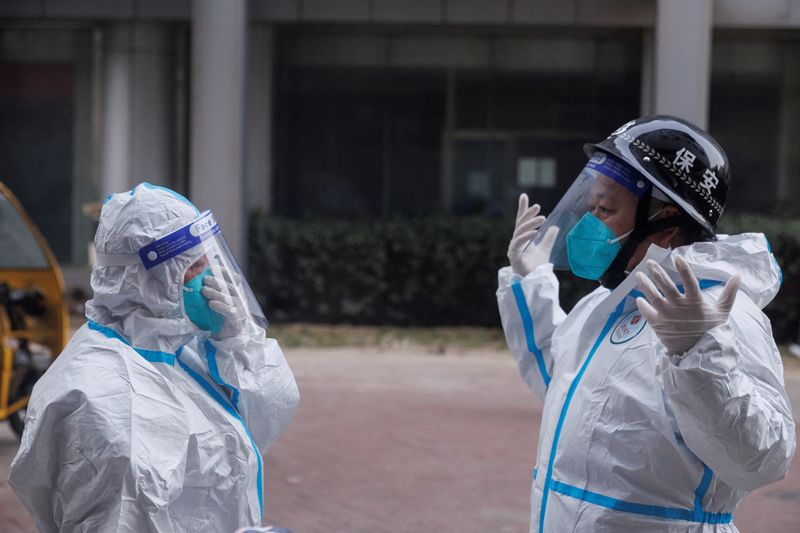By Brenda Goh
SHANGHAI (Reuters) -Beijing residents on Saturday cheered the removal of COVID-19 testing booths while Shenzhen said it would no longer require commuters to present test results to travel, as an easing of China's virus curbs gathered pace.
Although daily cases are near all-time highs, some cities are taking steps to loosen COVID testing requirements and quarantine rules as China looks to make its zero-COVID policy more targeted amid a sharp economic slowdown and public frustration that has boiled over into unrest.
The southern city of Shenzhen announced it would no longer require people to show a negative COVID test result to use public transport or enter parks, following similar moves by Chengdu and Tianjin.
Many testing booths in Beijing have been shut, as the capital stops demanding negative test results as a condition to enter places such as supermarkets and prepares to do so for subways from Monday. Many other venues, including offices, still require testing.
A video showing workers in Beijing removing a testing booth by crane onto a truck went viral on Chinese social media on Friday.
"This should have been taken away earlier!," said one commentator. "Banished to history," said another.
Reuters could not immediately verify the authenticity of the footage. At some of the remaining booths, however, residents grumbled about hour-long queues for the tests due to the closures.
CHINA OUTLIER
Three years after COVID emerged in central China, the nation has been a global outlier with a zero-tolerance approach of lockdowns and frequent testing. The authorities say the measures are needed to save lives and avoid overwhelming China's healthcare system.
China began tweaking its approach last month, urging localities to become more targeted. Initial reactions, however, were marked with confusion and even tighter lockdowns as cities scrambled to keep a lid on rising cases.
Then a deadly apartment fire last month in the far western city of Urumqi sparked dozens of protests against COVID curbs in over 20 cities in a wave unprecedented in mainland China since President Xi Jinping took power in 2012.
Authorities detained several people who participated in the protests and police in cities such as Shanghai have been checking commuters' phones for apps or virtual private network software that protesters used to communicate, according to protesters and social media posts.
On Saturday, police kept a heavy presence around Liangmaqiao junction in east Beijing, as authorities sought to put off any potential follow-up to last weekend’s unrest.
A similarly large police presence could be seen on streets close to Shanghai's Wulumuqi Road, which is named after Urumqi and was the site of a vigil for the victims of the fire that turned into protests last weekend.
FURTHER REDUCTIONS COMING
China is set to further announce a nationwide easing of testing requirements as well as allowing positive cases and close contacts to isolate at home under certain conditions, people familiar with the matter told Reuters this week.
Xi, during a meeting with European Union officials in Beijing on Thursday, blamed the mass protests on youth frustrated by years of the pandemic, but said the now-dominant Omicron variant of the virus paved the way for fewer restrictions, EU officials said.
Officials have only recently begun to downplay the dangers of Omicron, a significant change in messaging in a country where fear of COVID has run deep.
On Friday, some Beijing neighbourhoods posted guidelines on social media on how positive cases can quarantine at home, a landmark move that marks a break from official guidance to send such people to central quarantine.
Still, the relief has also been accompanied by concerns, especially from people who feel more exposed to the disease.
Many analysts say they still do not anticipate a significant reopening until at least after March, as China must first achieve results in a just-launched vaccination drive targeting the elderly.
Estimates for how many deaths China could see if it pivots to a full reopening have ranged from 1.3 million to over 2 million, though some researchers said the death toll could be reduced sharply if there was a focus on vaccination.
"None of this should be interpreted as a fundamental shift away from the zero-COVID policy but rather an effort to make it more streamlined and less costly. The goal is still to get cases back close to zero," Capital Economics said in a note, referring to the recent fine-tuning of policy.

"The alternative of letting the virus spread widely before more of the elderly are vaccinated and healthcare capacity has been ramped up would result in a higher death rate than in many Asian countries that reopened earlier, undermining China’s zero-COVID success," they said.
China reported 32,827 daily local COVID-19 infections on Saturday, down from 34,772 a day earlier. As of Friday, China had reported 5,233 COVID-related deaths and 331,952 cases with symptoms.